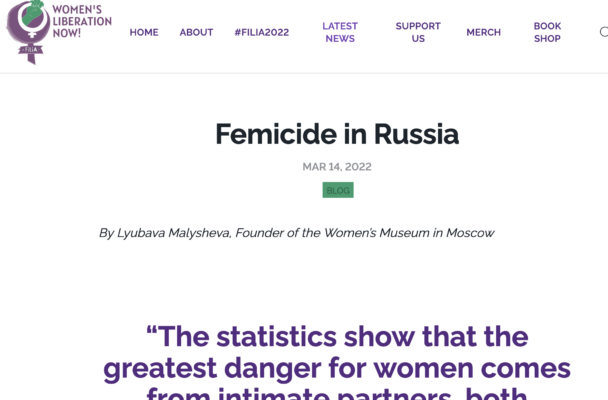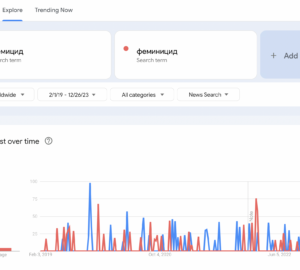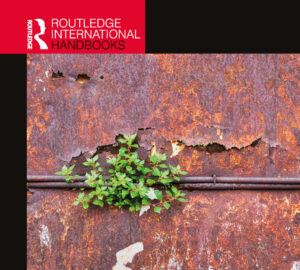Конференция, выступление для которой с некоторыми обновлениями, напечатано теперь на сайте FiLiA, проходила в октябре 2021 года, в Портсмуте. Что такое борьба с фемицидом – с высшей степенью мачистской агрессии против женщин? Это о приоритетах общества. И теперь мы видим, во что перетекает систематическое безнаказанное экстремальное насилие по отношению к женщинам в собственной стране. Если бы три года назад, в 2019 году, femicid.net получил достаточную поддержку от российских журналисток, феминисток и правозащитниц – не было бы этой войны, потому что переменилась бы культурная парадигма, мачистское насилие как одобряемая и культивируемая социальная норма потеряло бы свои позиции. Одно слово. Но были же другие, более важные дела у женщин, которые теперь не прочитают этот пост в фэйсбук. Думаю, что получивший резонанс кыргызский и начатый украинский аналогичные проекты послужили своевременным социальным переменам. Я продолжаю считать, пока приходят алерты и не отключен интернет – властям не удаётся спрятать фемицид даже на фоне военных новостей. Конечно, я думала остановить подсчёт, я и раньше держалась на пределе возможностей, а теперь очень трудно. Много сообщений о военном фемициде, который происходит на территории Украины – я не имею ввиду только бомбардировки роддомов, больниц и смерти из-за войны, но убийства и изнасилования, которые совершаются российской армией. Фемициды документируются в Украине и за них будет отвечать Россия. Любава Малышева.
оригинал текста на сайте FiLiA
Femicide in Russia
By Lyubava Malysheva, Founder of the Women’s Museum in Moscow
“The statistics show that the greatest danger for women comes from intimate partners, both present and former; familiar men. It is not customary to talk about this, but sons and grandchildren are also dangerous to women. In 2021, 135 women were killed by their son and 19 by their grandson.” — Lyubava Malysheva
In October 2021, I was pleased to attend the FiLiA conference to speak about femicide in Russia. I have adapted my speech for this article, updating it to reflect 2019-2021 data as included in the recent submission by Femicid.net to the UN Human Rights Committee and adding new information.
Femicid.Net
Femicid.net is an independent project, founded in 2019 to collect and analyse information on femicide cases in Russia and publish data in the public domain. Every year, between 20 and 30 volunteers work on the project. Our definition of ‘femicide’ is the killing of women by men on the basis of hatred of women. Russian authorities and journalists have no definition for femicide. In Russia, the word ‘femicide’ is not popular with either feminists or the authorities. They prefer to replace it with the words ‘domestic violence’, ‘domestic murder’, ‘murder of passion’.
We have recently submitted our third report to the United Nations since 2020 on femicide in Russia, with data for 2019-2021.
Femicide Statistics
There are no official statistics on femicide in Russia, while the information about the proportion of women affected by other crimes, where both women and men may become targets according to the Criminal Code, is blurred within the general data.
Femicid.net uses Google alerts and regional sites of the Russian Investigative committee as sources for our statistics. According to data for 2019, in the Far East Federal District of Russia the femicide rate per 100,000 women reached 4. In some other regions of the country it reached 7. In 2020, the femicide rate was 12 in one of Russia’s regions. By comparison, UN Office on Drugs and Crime data for 2016 indicates that in Spain the femicide rate was 0.5, and in Germany it was 1.1.
The statistics show that the greatest danger for women comes from intimate partners, both present and former; familiar men. It is not customary to talk about this, but sons and grandchildren are also dangerous to women. In 2021, 135 women were killed by their son and 19 by their grandson.
We don’t know anything about most of the killed women. When we know details, the victims are most often pensioners, saleswomen, schoolgirls, businesswomen, unemployed, involved in prostitution, homeless women, students and medical workers. Their killers are unemployed, pensioners, drivers, policemen, homeless men, students, servicemen and schoolchildren. Of the 1761 documented cases of femicide in 2019, we found that girls are killed from birth, with 26 below the age of 6, while males are dangerous at any age, with 21 between the age of 7 and 18.
We know the method of murder for almost all the cases. Beatings and murders with a knife are typical for Russia. They are followed by strangulation. Murders with occurrences of arson, dismemberment and the use of firearms are the most socially dangerous, and get presented by the news as big sensations which shape the culture of femicide in Russia. If a Russian woman is killed, it likely happens in her home or in the home of her intimate partner. Women are killed less often on the street.
It is often believed that anyone who kills women is crazy. However this is a silly generalization and a justification for femicide. Mental illness is not the cause of femicide, but it can release the patriarchal attitudes of society. A typical stereotype in Russia is that women are killed by strangers and drug addicts in the forest. In reality it is men familiar to them that kill them at home, and they are not drug addicts, but alcoholics.
Crime and Punishment
According to the report Crime and Punishment: What to do with Russian Prisons (2019), by Olga Shepeleva (Head of the Law and Rulemaking in the Digital Environment project at the Center for Advanced Management Decisions),
93% of released prisoners are sent to prison again. We have found cases when the killer was in prison 10 or more times. The law in Russia can be interpreted very broadly, and some murderers receive fines and suspended sentences, and some receive life sentences. It depends more on the corruption and passivity of society than anything else.
The Russian prison is now a femicide factory. By placing a rapist or a killer there, he learns even more cruel ideas. Then he is released from the prison without any socialization and without any kind of support or supervision. We need a reform of justice. I think the punishment for femicide should be life imprisonment. However, it shouldn’t be a prison, but more like a restricted territory without women.
Unfinished femicide
In 2020, Femicid.net started researching ‘unfinished femicide’. We define it as any attack on women. We had anticipated that the picture would be different and it was. As opposed to cases of finished femicide, attacks by strangers dominate the statistics.
There are more cases of unfinished femicide but it is reported less. The victims have another social status. Typically men attack with the intent to rape. There are many cases of unfinished resource femicide (for example, robbery). Often there are more than one victim. All cases where a woman successfully defends herself are unfinished femicide. The majority (91%) of Russian women convicted of ‘excessive self-defence’ had defended themselves from intimate partners and relatives.
Media
Russian news contains mostly negative frames of femicide cases, with very few positive frames. Our 2022 report to the UN looked at 282 messages about femicides in Russia for the period of January – March 2021. Direct or indirect victim blaming is represented in 80 articles, the voice of authority (while neglecting the voice of family or friends) in 271, the presentation of the issue as a local problem in 274, noting there is no history of previous violence in 234, racism in 5 cases and romanticising violence as love in 31 stories. A positive description of the victim’s life and personality was found in just two articles. In this way, the news forms a femicide culture. There are many studies from different countries that show this.

Having researched the framing of femicide since 2019, I wrote to many journalists in Russia, but nobody, including my editor, believed that the media influenced femicide. It worried me so much that one night I wrote libretto to an opera. Now it is our large all-women opera: The Journalist. It recently received a special diploma “Challenge of Time” at a major international competition for composers in Moscow. This is an opera about the influence of the media on femicide. And we have high hopes that this opera will be able to change the situation in Russia and the world. The opera can be staged in any country and is a direct musical action against femicide. We are crowdfunding for the Moscow Women’s Museum to stage the opera in 2022.
Femicid.net will continue to collect and analyse information on femicide cases in Russia and welcomes support to change the cultural paradigm that perpetuates sex-role stereotypes, leading to an increase in violence against women and girls.
Previous interview: https://www.filia.org.uk/latest-news/2020/8/24/why-russia-is-not-safe-for-women
Lyubava Malysheva is a radical journalist, civic activist, poet. An emigrant from Russia, I lived in Norway for 7 years, now I live in Spain. I am engaged in the creation of the Moscow Women’s Museum and monitoring of femicide in Russia. Librettist and producer of the opera about the influence of media on femicide “Journalist”. Author of photobooks on activism in Bergen, author of articles on global activism around the world for Radio Free Europe, author of books from the series Women’s Story for Children. An activist of the women’s historical and urban movement. Vegan.


